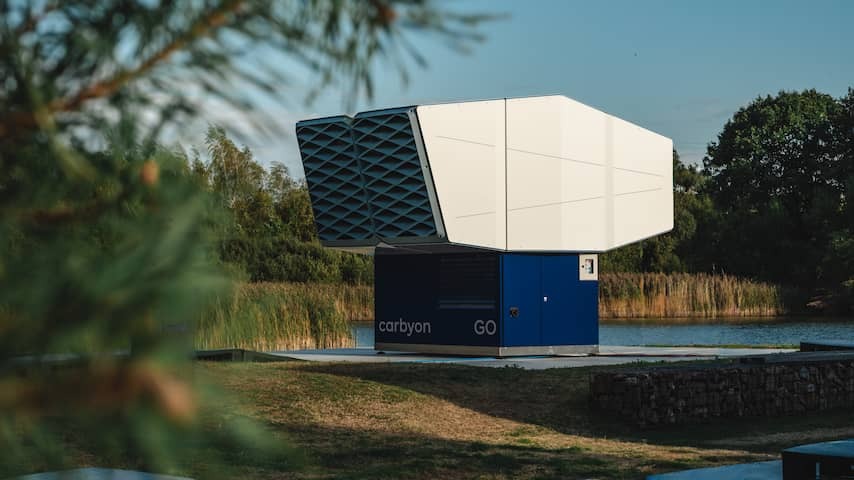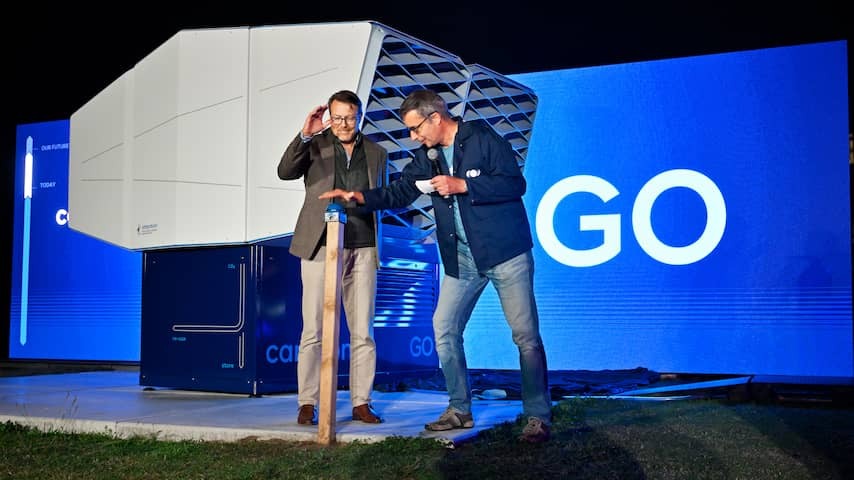
The Eindhoven start-up Carbyon presented a demonstration version of a machine to remove CO2 on Wednesday. The company hopes to build thousands of those machines to tackle the climate problem. Then large obstacles still have to be overcome.
The CO2 vacuum cleaner looks a bit like a props from a science fiction film, appears as carbyon director Hans de Neve and ‘start-up prince’ Constantijn reveal him on Wednesday evening. The angular device was not out of place on a spaceship in Star Trek .
This device does not fly into the air, but brings in air with fans. On the inside, the CO2 molecules from the air – about 420 pieces per million air particles – are attached to an ultra -run layer of material. This is then heated with a heat pump, after which the pure CO2 comes loose and is collected.
Carbyon’s technology says it works two hundred times faster than those of other start-ups that work on CO2 removal from the air. This demonstration model will take care of 3 tons of CO2 per year. Carbyon promises that the next version, which will be the same size, can even remove 75 tons per year. That is equivalent to the climate impact of just under five Dutch households.
So many of those machines are needed to put sods. Carbyon hopes to produce tens of thousands of such devices in a few years. Ultimately, it should even be millions, so that billions of tons CO2 can be removed per year.
Energy consumption for the time being high
To prevent climate change, it is first of all important to reduce our CO2 emissions as much as possible. But as a supplement it is also necessary to develop methods for CO2 removal, the Scientific Climate Council (WKR) wrote in an advice to the cabinet last year. That can compensate for the remaining emissions and ultimately even reverse the climate change.
This is possible in theory in various ways, for example by taking care of CO2 in energy production with biomass or removing the greenhouse gas from the ocean. Direct CO2 removal from the air is developed worldwide by various start-ups.
In addition, the required energy is an obstacle. During the presentation of the Neve, the energy consumption of the CO2 vacuum cleaner remains remarkably unnamed. Afterwards, the Flemish Carbyon founder tells NU.nl that the demonstration model needs 10,000 kilowatt hours of electricity to remove one ton of CO2. That is equivalent to the annual consumption of nearly four households.
If that current is removed from the Dutch electricity grid, more CO2 will be made in the air due to the required power plants than the device itself removes from the air. The demonstration machine is not yet a climate solution.
In the next version, the power consumption will fall by three -quarters, De Neve promises. In addition, the devices must ultimately be directly linked to clean energy sources, so that there is no CO2 emissions at the electricity generation. Calculations that Carbyon carried out in collaboration with Radboud University shows that the climate impact of the CO2 vacuum cleaners, including the production of the steel and other materials, then turns out beneficial.
‘Devices are used in places with lots of potential’
Not everyone is convinced that we will filter CO2 out of the air on a large scale. Because there are relatively few CO2 particles in the air, it will always be difficult to remove the greenhouse gas, says Heleen De Coninck. She is professor of system transitions and climate change at Eindhoven University of Technology and co-wrote the WKR report.
According to her, it is important to do further research into this. “I think it is fantastic that we have a few companies in the Netherlands that are working on the road. But I think it will remain a relatively small market, because it is almost impossible to get energy use down.”
“These devices will be used at locations in the world where there is a lot of potential for renewable energy,” says De Neve. “Then you have to think of desert areas or geothermal areas such as in Africa.” This is because deep soil heat can be used there and, according to him, it is possible to generate cheaply clean energy. But according to De Coninck it is a “fairy tale” to think that that energy will be very abundant and cheap in the short term.
Goal is 100 euros per ton of CO2
The investors who already put more than 25 million euros in Carbyon are probably different about that. Ultimately, the company hopes to reduce the costs to around 100 euros per removed ton of CO2. That would make it attractive for companies to permanently save CO2 or to use the green CO2 as a raw material in sustainable fuels or other processes.
There are still big steps for that. De Neve now says to see opportunities to reduce costs to 200 euros per tonne of CO2. “In the coming years we have to work with the engineers to see how we can optimize things to make it 100 euros per ton.”
The company depends on solid worldwide climate policy. CO2 removal pays off for companies only if CO2 emissions and the use of fossil fuels is strongly discouraged. “Governments have an important role by ensuring that discharging CO2 into the atmosphere does not remain free,” says De Neve.
Eindhoven-based start-up carbyon presented a demonstration version of a Machine to Extract CO2 from the air on Wednesday. The Company Hopes to Build Thousands of thesis machines in the Future to Combat The Climate Problem. However, major obstacles still need to be overcome.
The CO2 Vacuum Cleaner Looks A Bit Like A Prop From A Science Fiction Film, As Carbyon Director Hans De Neve and ‘Start-Up Prince’ Constantijn Revealed on Wednesday Evening. The Angular Device would not have looked out of place on a spaceship in Star Trek .
This device does not fly into the air, but uses fans to draw in air. Inside, the CO2 Molecules from the Air – About 420 per Million Air Particians – Attach Themselves to an Ultra -Thin Layer of Material. This is then heated with a heat pump, after which the pure co2 is released and captured.
Carbyon’s Technology Reportedly Works Two Hundred Times Faster Than Other Start-ups Working on Co2 Removal From the Air. This demonstration model will capture 3 tons of CO2 per year. Carbyon Promises That the Next Version, which will be the same size, will be able to remove 75 tons per year. That is equivalent to the climate Impact of Just Under Five Dutch Households.
In order to make a significant impact, many or thesis machines are needed. Carbyon Hopes to Produce Tens of Thousands of Such Devices in Just A Few Years. Ultimately, There Should Be Millions, So That Billions of Tons of CO2 Can Be Removed per year.

Energy Consumption Still High for Now
To combat climate change, it is first of all importing to reduce our co2 emissions as much as possible. But as a supplement, IT is also necessary to develop methods for CO2 Removal, The Scientific Climate Council (WKR) Wrote Last Year in An Advice to the Government. This can compensate for the remoining emissions and ultimately equally reverse climate change a little.
In Theory, this can be done in Several Ways, for Example by capturing CO2 Turning Energy Production with Biomass or Extracting the Greenhouse Gas from the Ocean. Direct CO2 Removal from the Air is Being Developed Worldwide by Various start-ups.
The Energy Required is an obstacle. Duration De Neve’s Presentation, The Energy Consumption of the CO2 Vacuum Cleaner Remains Remarkable Unmentioned. Afterwards, The Flemish Carbyon Founder Tells NU.nl that the demonstration Model Requires 10,000 Kilowatt Hours of Electricity to Remove One Ton of CO2. That is equivalent to the annual consumption of almost four households.
If that electricity is a drawn from the Dutch electricity grid, More CO2 is released into the air by the reploreed power plants than the DeVice itself removes from the air. The Demonstration Machine is Therefore Not Yet A Climate Solution.
In A Next Version, The Power Consumption Will Decrease by Three Quarters, De Neve Promises. In Addition, The Devices Must Ultimately BE Direct LINKED TO CLEAN ENERGY SOURCES, So That Are No CO2 Emissions Duration Electricity Generation. Calcals that carbyon carried out in collaboration with Radboud University Show that the climate Impact of the CO2 vacuum cleaners, including the production of the steel and other materials, is then favorable.
‘Devices will be deployed in Places with a Lot of Potential’
Not Everyone is convinced that we are going to filter CO2 from the air on a Large Scale. Because there are relatively few CO2 Participes in the Air, it will always be difficult to remove the Greenhouse Gas, Says Heleen De Coninck. She is Professor of System Transitions and Climate Change at TU Eindhoven and Co-Wrote the WKR Report.
Accordance to her, it is important to conduct further research into this. “I think’s fantastic that we have a few companies in the Netherlands that are working hard. But I think it will remain a relatively small market, because it is Almost Impossible to reduce energy consumption.”
“These devices will be deployed in locations in the world where there is a lot of potential for renewable energy,” De Neve Says. “You should think of desert areas or geothermal areas such in Africa.” Deep geothermal heat can be used there and, accordance to him, it is Possible to Generate Clean Energy Cheaply. But accordance to the coninck, it is a “fairy tale” to think that energy will Become very abundant and cheap in the short term.
Goal is 100 euros per ton or CO2
The Investors Who Have Already Invested More Than 25 Million Euros in Carbyon Probably Think Differently About this. Ultimately, The Company Hopes to Reduce Costs to around 100 euros per ton of CO2 Removed. That would make it attractive for companies to permanently store CO2 or to use the green co2 as a raw material in Sustainable Fuels or Other Processes.
Major Steps Are Still Needed for this. The Neve Says He Now sees Opportunities to Reduce Costs to 200 euros per ton of CO2. “In the Coming Years, we have to work with the engineers to see how we can Further Things to make it 100 euros per ton.”
The Company is Dependent on Strong Global Climate Policy. CO2 Removal Only Pays Off for Companies If the Emission of Co2 and the Use of Fossil Fuels Are Strongly Discouraged. “Governments have an important role to play by ensuring that dumping CO2 into the atmosphere does not remain free,” Says de Neve.